Yellow snakes look spectacular and tropical. Various species of snakes can be yellow.
This includes large pythons, agile, boas, or arboreal Morelia snakes.
Common in the exotic snake pet world, these snakes are also seen in the wild, particularly in rainforests and woodlands.
Here are the most common species of snakes that are yellow and what makes them different.
Table of Contents
1. Albino Ball Python
The Albino Ball Python (Python regius) is one of the common yellow snakes in the snake pet world.
This species is seen in a lime yellow color mixed with white marks.

Albino Ball Pythons grow to a size of up to 6 feet. They can survive up to 30 years in captivity.
Snakes of this genus are native to Africa. They are rarely seen outside private collections in North America.
Albino Ball Pythons are part of a group of ball pythons that get their name from curling into a ball to protect the head.
These snakes are known for their docile temperament which makes them a common snake pet option.
Albino Ball Pythons aren’t aggressive towards humans as they prefer to spend much of their time hiding.
These snakes can be handled in short weekly sessions before becoming defensive.
2. Green Tree Pythons

The Green Tree Python (Morelia viridis) is found in Australia and nearby islands.
Snakes of this genus are born yellow. They have a bright banana-yellow color that remains yellow for up to 12 months.
As these juvenile snakes mature their color turns green with some yellow undertones or yellow marks on the side of the specks.
Snakes of this genus are known for their ability to climb. They easily make their way up trees and they remain on branches sitting in a curled ball position like many other pythons.
Most of these snakes live very solitary lives. They only come down for food using their capacity to quickly detect warm-blooded prey.
Constriction is among the mechanisms used by this species to overpower its prey.
Mating season is the only time when these snakes aren’t solitary. Female Green Tree Pythons can lay up to 35 eggs per season.
3. Albino Burmese Python
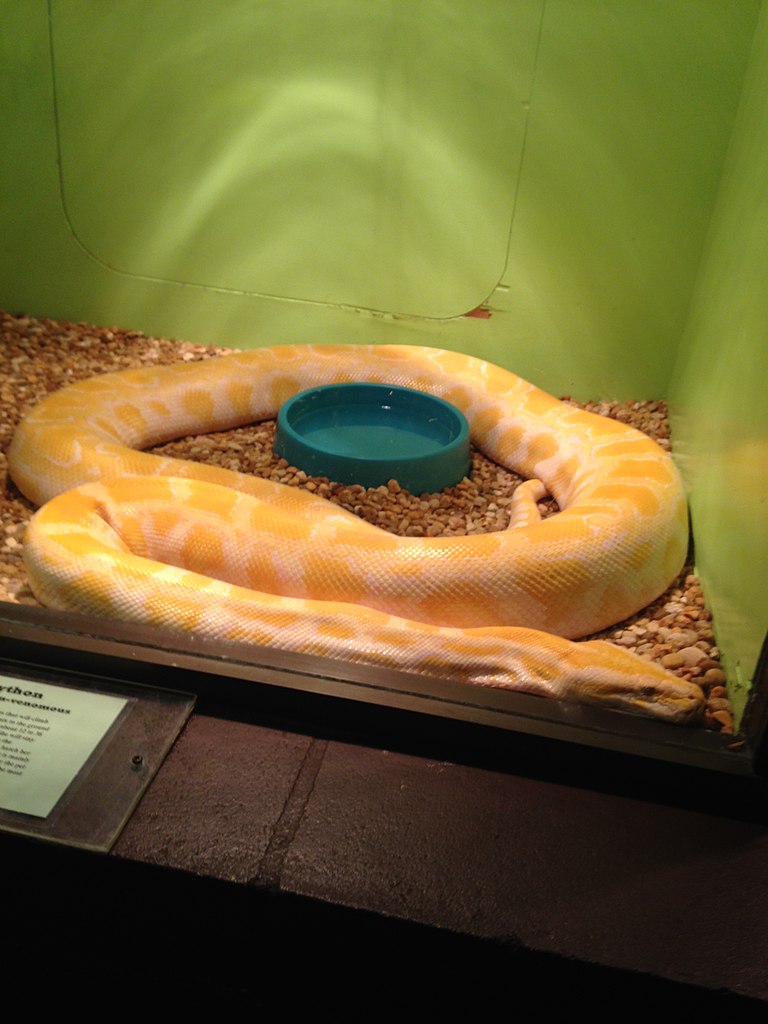
Albino Burmese pythons (Python bivittatus) are some of the largest yellow snakes in the world.
They grow to a maximum length between 13 and 18 feet. Even newly-hatched Albino Burmese Pythons measure at least 22 inches.
This species is known for its white and yellow coloring which makes for a bright species compared to other dark brown Burmese pythons.
Snakes of this genus are some of the largest in the world. They live in marshes in Asia and they’re known for eating frequently to support their large size.
Albino Burmese pythons don’t have very good vision. They rely on thermoreceptors to catch food such as rodents or small birds.
Snakes of this genus wrap around prey and suffocate it.
Albino Burmese pythons have adapted jaws they use to swallow prey entirely.
4. Reticulated Python

Reticulated pythons (Malayopython reticulatus) are found in a bright yellow and white morph. This is a rare morph seen next to water sources.
Yellow Reticulated pythons are mostly found in Southeast Asia.
These pythons live in woodlands, rainforests, and grassland next to water sources. They might also be found outside of these areas during the mating season.
Reticulated pythons are terrestrial but also good swimmers.
Their good swimming skills are what made them increase their habitat to islands next to coastal areas.
Snakes of this genus are ambush predators.
This means they have to wait for small prey to get within easy reach to attack.
Reticulated pythons eat small rats and other rodents.
Female Reticulated pythons can lay as many as 80 eggs per clutch.
5. Moluccan Python
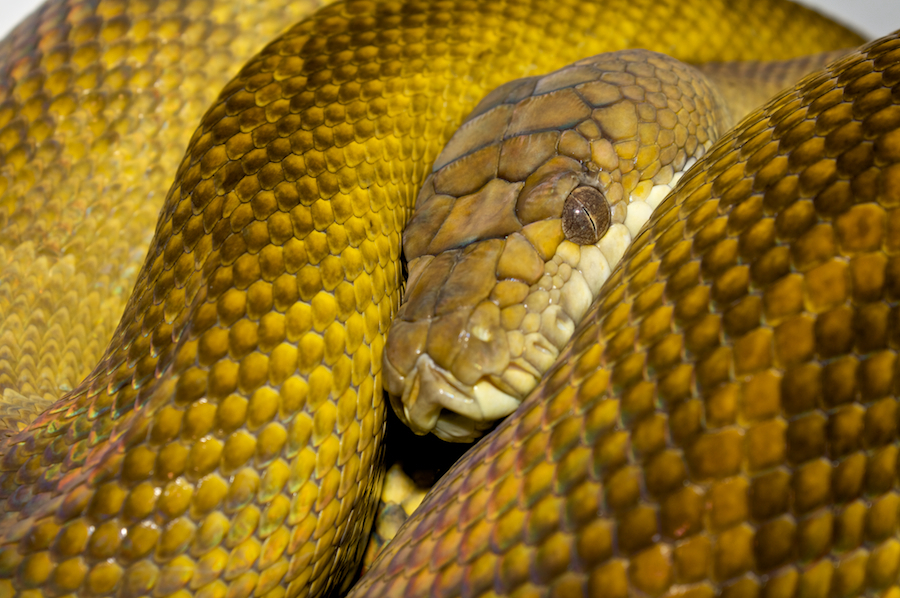
Moluccan Pythons (Simalia clastolepis) come in different morphs. As adults, they are known to have a yellow and gray or yellow or brown coloring.
As young snakes, Moluccan Pythons can be mostly yellow as they change colors through different life stages.
These snakes are born red or orange. This color changes to dominant yellow within 6 months and remains yellow up to the age of 3.
Snakes of this genus can then morph into a dark brown color. All of the morphs based on yellow coloring are known for the interest they spark in the pet snake world.
6. Albino Red Tail Boa
This is one of the largest yellow snakes that aren’t venomous. Snakes of this genus are also called the Common boa.
This snake is very common in Southern America.
It’s here that its gray and brown morphs are the most common.
The species is known for a pigmentary disorder called albinism. This is a condition also known as the absence of melanin.
Albino Red Tail Boa is the result of this condition.
This is why this snake has a mostly white and yellow body that appears very bright as opposed to the dominant darker coloring of the species.
Snakes of this genus might be known for a pigmentary disorder, but they live in the same rainforest habitat with the same rodent diet preferences as the dominant color snakes of the Red Tail Boas.
Snakes of this genus live in high humidity areas such as rainforests.
They are good swimmers and often make a quick water escape when threatened.
Albino Red Tail Boas (Boa constrictor) spend a lot of time hiding in rodent burrows. They only come out at night.
7. Corn snake

Corn snakes (Pantherophis guttatus) come in different morphs. These colorful snakes are even seen in an albino morph.
The Gold Dust Striped Bloodred Corn Snake is known for its yellow color with 2 red stripes on its dorsal.
Corn snakes are mostly seen in Southeastern US when it comes to their North American presence.
Snakes of this genus are adaptable when it comes to altitude as they have been discovered as high as 6.000 feet.
Corn snakes like to live in overgrown fields and abandoned crops.
Selective breeding has made Corn snakes one of the species with an abundance of morphs and hybrids.
All of them are carnivorous.
Corn snakes eat rodents, reptiles, and bird eggs.
8. Hognosed snake

The Arctic Albino Superconda is one of the yellow hybrid morphs of the Hognosed snake.
This morph is almost completely yellow with dark yellow or pink marks on its head.
Snakes of this genus are known to thrive on amphibians, both in captivity and in the wild.
Western Hognose snake morphs are often yellow dominant or come in many different types of patterned colors with yellow.
This snake species is mildly venomous.
Not dangerous to humans, the mildly venomous saliva of this species is used against small prey.
Hognosed snakes use their mildly venomous saliva to incapacitate toads.
9. Kingsnake
Different Kingsnake morphs make this common species one that can be found in yellow coloring.
The Jelly Florida Kingsnake and the Albino Kingsnake are mostly yellow versions of this species.
The Jelly Florida Kingsnake is the result of combining the tan Peanut Butter Kingsnake with the Albino kingsnake that cannot produce melanin.
Kingsnakes are a common predator species.
They feed on vertebrates. You can feed small birds to captive Kingsnake hybrids.
Kingsnakes are a species adapted to living in various habitats across North America.
These snakes can live both in humid and dry climates.
Most Kingsnakes live in woodlands, tropical forests, and deserts.
10. Rat snake
Rat snakes come in various morphs.
The Albino Japanese Rat Snake is a mutant species bred by pet snake owners.
Snakes of this genus are mostly white and yellow with distinct red eyes.
A lack of melanin is what created this unique yellow snake.
Snakes of this genus can be as long as 6 feet. They are common in Japan and nearby territories.
The Japanese Rat snake has a long history in its native country. It has been used by local farmers to control rat problems on crops.
As its name suggests, the Japanese Rat snake eats rats on farms and crops.
However, this species has very good climbing abilities. It can eat birds and bird eggs as a result.
Lizards are often fed to captive yellow Rat snakes.
11. Military Ground Snake
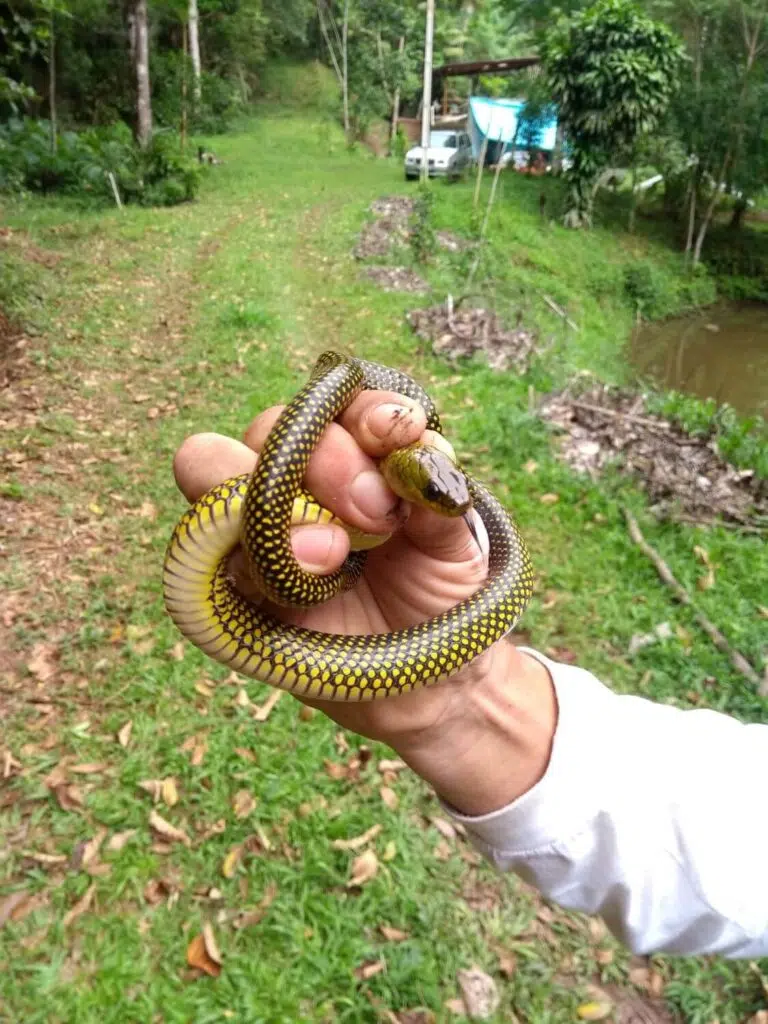
The Military Ground Snake (Erythrolamprus miliaris) is common in the rainforests of Brazil and South America.
It’s also found in countries such as Uruguay and Paraguay.
Most Military Ground snakes live in deciduous forests which means they like to hide in the leaves of the trees that fall at the end of the summer.
Most of these forests are found in tropical and subtropical regions.
This species has a partial yellow color with an olive or gray-green dorsal and a yellow underbelly.
While the dorsal is dark-colored, the specks are still yellow on the edges.
Snakes of this species like to feed on amphibians. Its semi-aquatic nature also allows it to feed on fish.
12. Malabarian Pit Viper

This venomous snake is found in Southwestern India. It’s available in different colors including yellow, green, and brown.
The yellow morph of the species is characterized by a dark yellow dorsal and a pale yellow underbelly.
One of the characteristics of the Yellow Malabarian Pit Viper (Craspedocephalus malabaricus) is its seasonality. The snake is only seen in the monsoon months.
When the weather changes, the wind starts blowing from the ocean and precipitation is frequent.
This is the best time to see the secretive nocturnal Malabarian Pit Viper.
On rare occasions, this venomous snake can be seen resting on warm rocks during the day.
Known for biting people without warning, the Malabarian Pit Viper isn’t the most dangerous pit viper.
Its venomous bite is painful. Local swelling and irritation are common.
These symptoms tend to disappear on their own.
Only found in the Indian Subcontinent, this snake species is small to medium in size. At best, it grows to a maximum length of 41 inches.
13. Eyelash Viper

This venomous snake species comes in different colors such as yellow, white, and orange.
Its yellow morph is a popular choice in the snake pet industry even if this species is highly venomous.
The snake gets its name from the myth it closes its eyelashes when it bites humans.
Common in South America, the species is endangered in places such as Costa Rica.
Snakes of this genus are solitary and very good at hiding. They prefer to eat small vertebrates and stay away from humans
Its hemotoxic venom is known to kill red blood cells and this is why the species is highly dangerous and should not be handled.
The Eyelash Viper (Bothriechis schlegelii) is a slow-moving snake. It uses ambushing techniques to pounce on prey.
It uses the same slow approach before biting people or other large predators of the species such as badgers.
14. Speckled Coralsnake
This snake species is often seen in yellow color with a black head and a narrow black dorsal band.
Common in Southeast Asia, the snake is part of the elapid genus. This is a type of snake that has erect fangs all the time.
Most seen in Thailand, this species is also seen in Myanmar.
Venomous and dangerous, the Speckled Coralsnake (Calliophis maculiceps) is found in multiple other morphs.
Its red morph is as common as its yellow morph. Both tend to have darker or black markings on the head.
This snake also comes in a dual green-yellow morph.
The dorsal of the species is green with a yellow underbelly and a black head.
15. Eastern Ratsnake
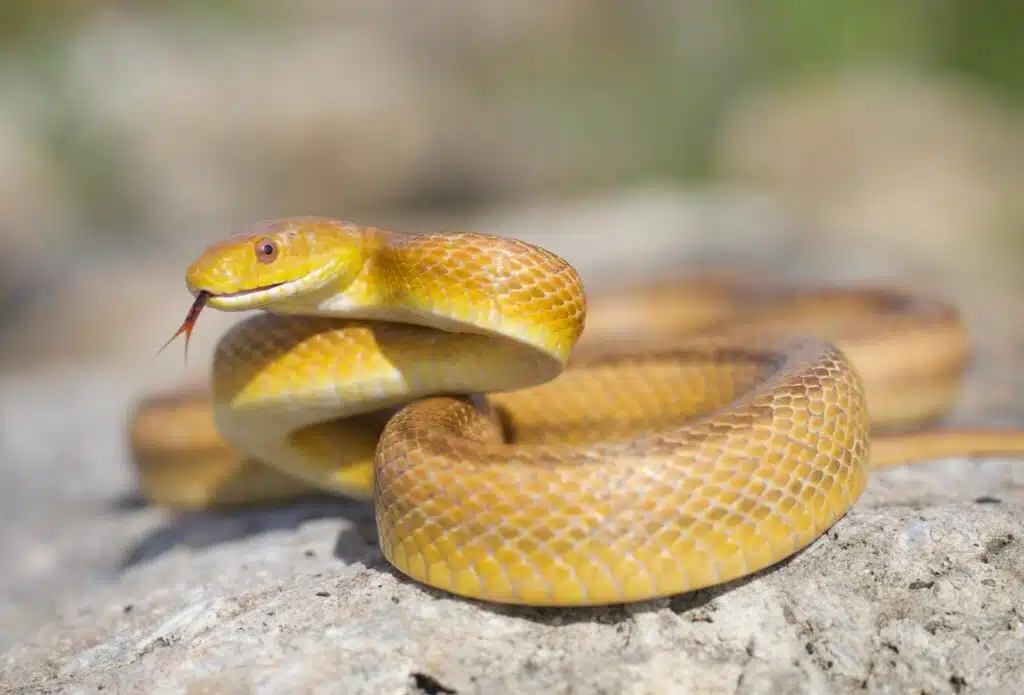
The Eastern Ratsnake (Pantherophis alleghaniensis) is also known as the Yellow Rat snake or the Chicken snake.
Eastern Ratsnakes grow up to a size of 72 inches.
The yellow morph of the genus has a mustard-yellow coloring with black dorsal stripes and a bright yellow underbelly.
Snakes of this genus are found in all habitats including farmland, woodlands, and wetlands.
The snakes are arboreal and they can be seen up in trees in the summer as the Eastern Ratsnake is diurnal. Their arboreal nature also means these snakes can make their way into attics where homes are near tall trees.
16. Yellow Blunt-headed Tree Snake
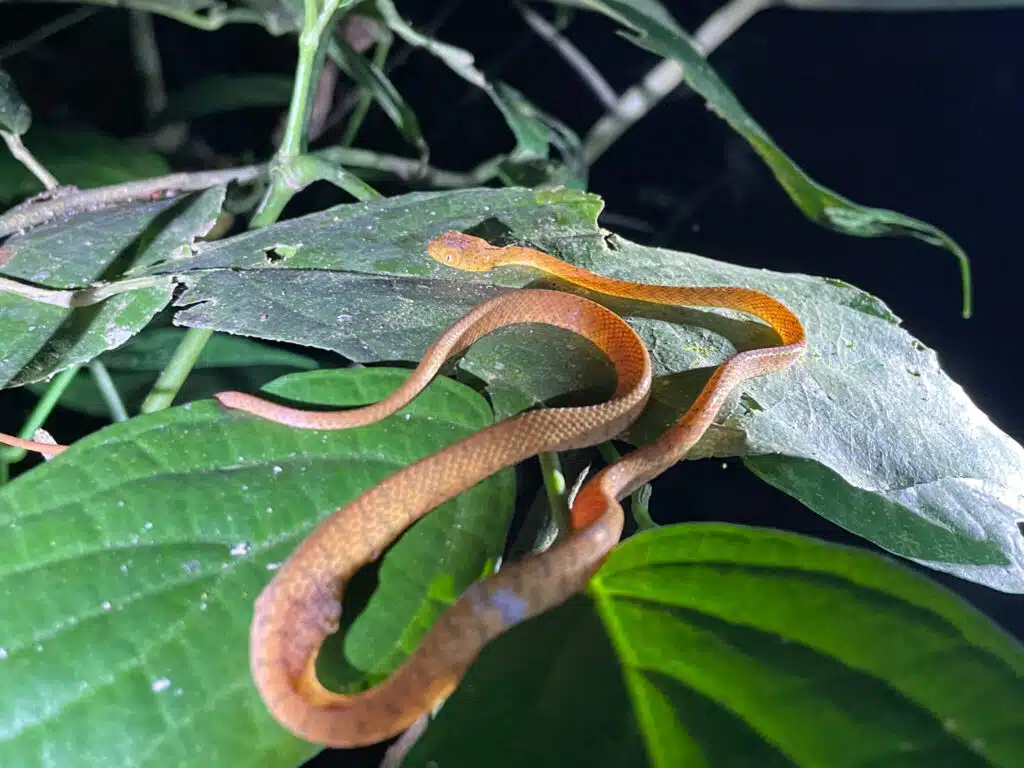
A small colubrid native to Central America, the Yellow Blunt-headed Tree snake (Imantodes inornatus) often comes in different shades of yellow.
The larger head of the snake may influence the name of the species but this snake is yellow also across the dorsum.
Bright yellow sections may be restricted to its underside while its dorsum shows darker yellow nuances.
This includes dark yellow, yellow-brown, or yellow-and-black colors. The black sections are represented by fine dots or marks.
Dark brown morphs are also common to this snake with a large head.
Growing to a length of just a few inches, The Yellow Blunt-headed Tree snake has a bright yellow color in its juvenile days.
It can be found in forests in deep vegetation.
17. Yellow Sea Snake
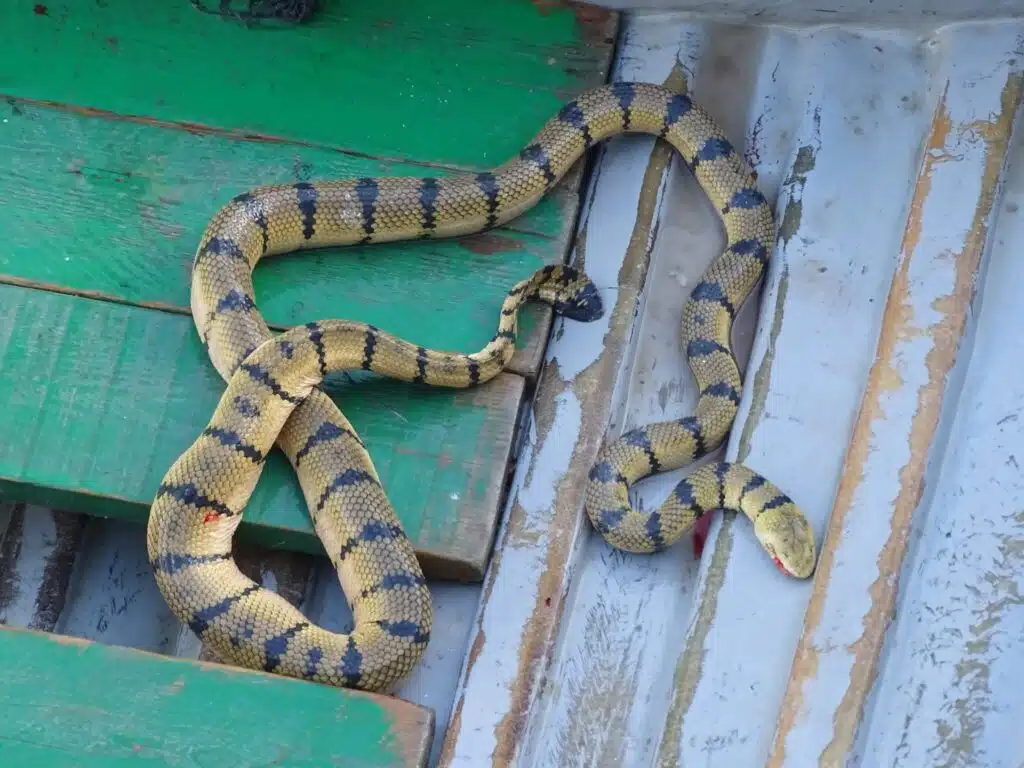
Initially just partly yellow, The Yellow Sea Snake (Hydrophis spiralis) eventually grows into an adult that has widespread yellow sections, along with more typical dark olive, brown, or black nuances.
Its sides and ventral color are yellow but Yellow Sea Snakes also show large yellow sections in half-moon shapes across its lower body, closer to the tip of its tail.
Yellow Sea Snakes also show some color variations depending on their region. For example, its Costa Rican morph may be almost completely yellow, except for the black marks on its head.
The extent of its range is still largely unknown.
Yellow Sea Snakes may be found in many places around the world.
Some theories argue these snakes move with ocean currents and never fully limit their areas to a single region of the ocean.
Like all sea snakes, The Yellow Sea Snake is also venomous.
Even a small amount of injected venom can have deadly effects. Medical treatment and antivenom are required once bitten.
18. Yellow Anaconda
Yellow Anacondas (Eunectes notaeus) are present in multiple countries of South America, including Brazil and Argentina.
This is one of the largest yellow snakes in the world, albeit not as large as The Green Anaconda.
Still, Yellow Anacondas can grow to a size of around 10 feet and are known to be highly aggressive and dangerous to small animals, reptiles, and even humans.
While this large yellow snake doesn’t inject venom in its prey, it tangles its body around it resorting to suffocation techniques to overpower all types of animals.
Yellow Anacondas are also some of the most difficult types of snakes to raise in captivity, in zoos around the world.
These rare snakes have unpredictable reactions, which makes them highly dangerous for zoo workers.
Its erratic behavior has also led to clear regulation changes in certain areas of North America.
For example, the advent of other large snakes that escaped from captivity in Florida has led to the ban of the species in the US.
19. West Coast Banded Snake

The mostly yellow base color is specific to The West Coast Banded Snake (Simoselaps littoralis).
This species comes in different yellow nuances. From bright yellow to dark yellow or yellow-orange, West Coast Banded Snakes go through different yellow nuance stages as they age.
As the name of the snake suggests, this is a banded species. Black bands are seen across the dorsum while its head is mostly bright gray.
In some cases, the head of the snake may look almost white.
A species that grows to about 15 inches, this is a type of burrowing snake.
Its thin head helps it dig through loose soils in its native range of Western Australia.
Snakes of the species aren’t necessarily adapted to their environment in terms of looks. They can burrow in coastal areas as well as in shrubland.
20. Wagler’s Pit Viper

Also known as The Temple Snake, Wagler’s Pit Vipers (Tropidolaemus wagleri) are native to Southeast Asia.
This snake has high color variation as it grows and matures. It goes from a black and yellow appearance to a green appearance.
Its yellow and black morph is characterized by a banded appearance.
A black base dorsum color is contrasted by bright yellow bands and yellow sections around its mouth.
Additional white specks are seen on its sides, between its yellow bands.
The head of the snake also shows additional white and yellow specks on top.
Wagler’s Pit Vipers are also further known for their yellow eyes. The eyes of these snakes remain yellow through their different life stages.
They can be almost completely yellow or partially yellow.
21. Mojave Shovelnose Snake

Mostly found in Inyo County, Mojave Shovelnose Snakes (Sonora occipitalis) are known for their unique cream-yellow base color.
The bright nuance of the species is contrasted by multiple brown bands along its body.
These brown bands are interrupted on the ventral side.
A burrower, The Mojave Shovelnose Snake is a species that has a small head and snout, used to dig itself into the ground during the day.
A nocturnal snake, the desert species of Mojave Shovelnose Snake come out for food at night with an occasional sighting during the day.
Some of the rare morphs of the species also come in a yellow base color, but typically of a darker nature.
This is a species that has a dark yellow or even yellow-brown color as it ages.
In some habitats, the black bands of Movaje Shovelnose Snakes can also be brown.
22. Banded Krait

A yellow snake with black bands, The Banded Krait (Bungarus fasciatus) is a common species in a wide area between China and India.
Its yellow base color has a darker nuance, closer to green.
This is an elusive species living a secretive life. A nocturnal snake, The Banded Kraits hides in the burrows of rodents.
It can also repurpose mounds and it may hide in there up until finding the next meal for which it moves around.
Branded Kraits mostly feed on other snakes, particularly on the juveniles of other species.
They rely on their venom to quickly paralyze the bitten snake. A potent venom is known to be produced by Branded Kraits. Its bite is dangerous and potentially lethal to humans.